Response to ‘A Critique of Lolita Fashion’
In The Cute Empire (ISBN 4791764862) published in 2009, the author cites the September 1987 issue of Ryuko Tsushin as the earliest mention of Lolita Fashion in print (and then puts it on their timeline a decade early…). The same article is referenced in Fashioning Japanese Subcultures (ISBN 1847889476) published in 2012. And it’s also mentioned in the Japanese wikipedia article, where there is some controversy about what the article is about and if it actually is talking about what we would consider lolita fashion, or if lolita is just being used as an adjective. I’ve been trying to buy a copy of this magazine since at least 2016 without success.
I recently started a group on Facebook called EGL Research Center for discussing academic topics related to lolita fashion, identifying items, etc and I figured why not, I’ll make a post and ask if anyone has access to this magazine. To my surprise and delight, the wonderful Ferro had it and was able to send me scans of the article in question. Needless to say I am beyond thrilled. (I’d normally insert a generic push to purchase your own copy of this magazine if you want to read the whole thing, but again… it’s super hard to find!).
I’ve reproduced the two pages in question below. I thought it might be interesting to go through the article and talk about it.
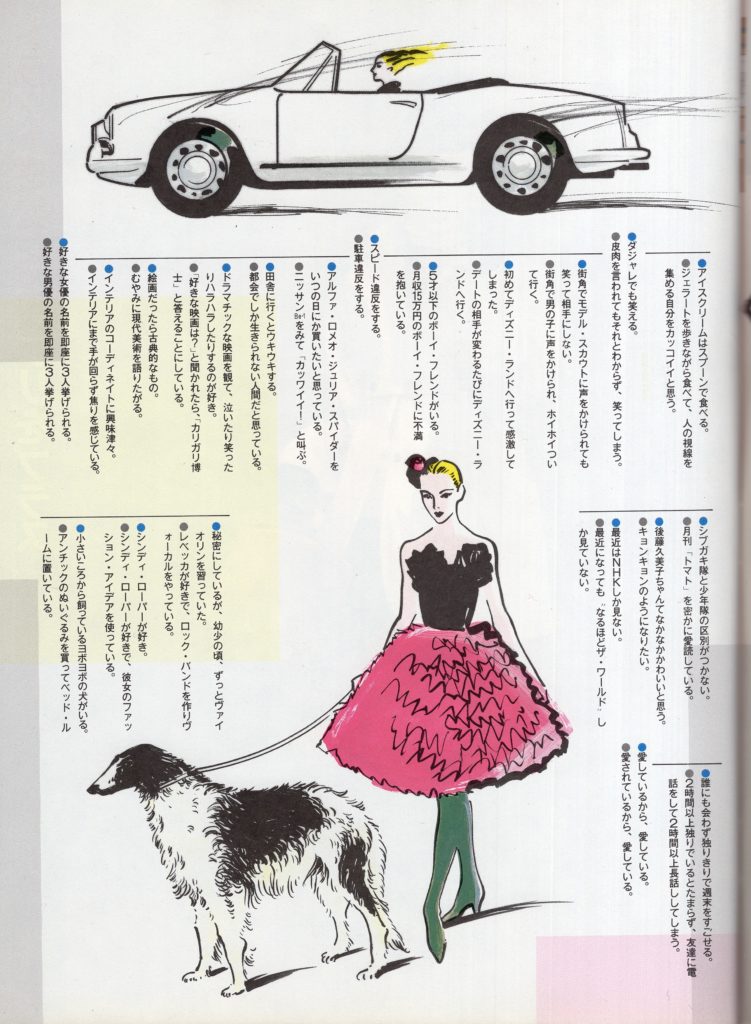
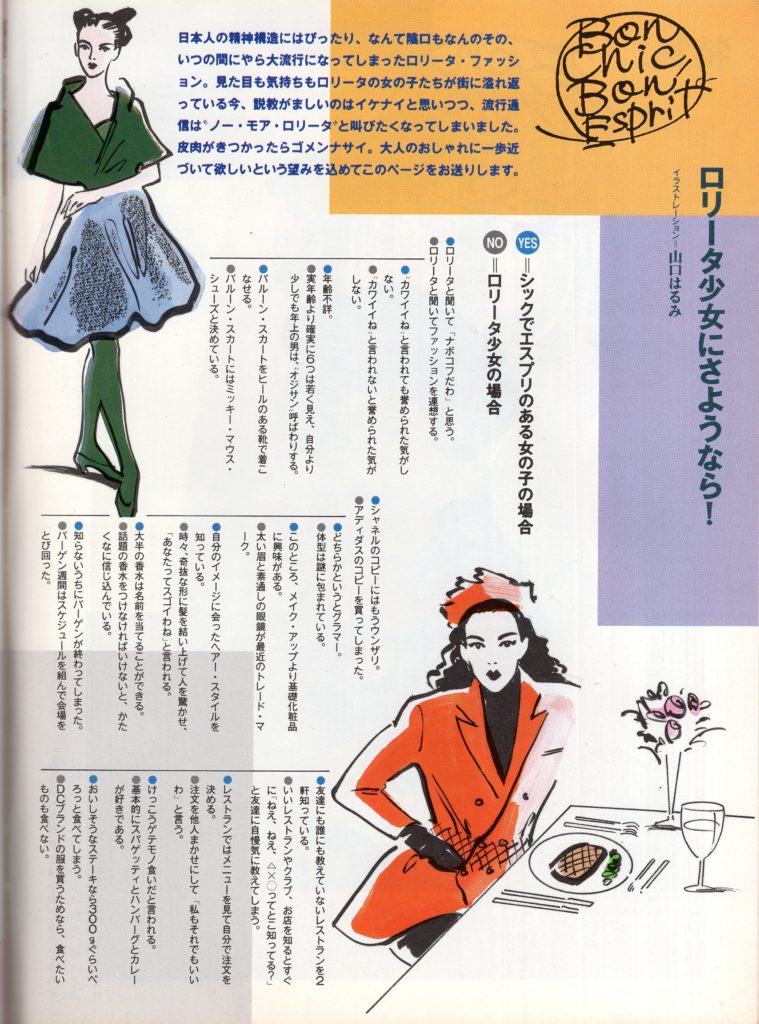
It starts off with an introduction, which I’ve paraphrased in English loosely below. Please note that this is only provided for context and may contain inaccuracies due to my lack of Japanese reading ability and/or typographical errors. If you are looking for an accurate translation of the article, please work with a professional translator. If you read Japanese, please read from the scanned pages above.
日本人の精神構造にはぴったり、なんて陰口もなんのその、いつの間にやら大流行になってしまったロリータ・ファッション。
Before we knew it, Lolita fashion became super popular, because it fit into the current Japanese social/mental structure.
見た目も気持ちもロリータの女の子たちが街に溢れ返っている今、説教がましいのはイケナイと思いつつ、流行通信はノー・モア・ロリータ”と叫びたくなってしまいました。
Now that girls who both wear and act like lolita are flooding the streets, I want to shout “No More Lolita!”.
皮肉がきつかったらゴメンナサイ。
I’m sorry if it’s a little too ironic.
大人のおしゃれに一歩近づいて欲しいという望みを込めてこのページをお送りします。
We have written these pages with the hope that you will become one step closer to being an adult.
So, interestingly, this starts off with the idea that the Lolita Fashion they are talking about isn’t just being introduced as a new thing. It’s popular, but it’s been around long enough for someone to be ‘sick’ of it, so to speak. This is consistent with later articles that I’ve seen about lolita fashion where designers talk about the name being applied on top of something that existed already.
The lavender side bar says “Goodbye to the Lolita Girl”, by the way. So this is definitely framing being the “Lolita girl” as not being a positive thing in the author’s point of view.
Then we have a key that designates the Blue dots as “yes” or “dos” and the black dots as “no” or “don’ts”.
Yes = シックでエスプリのある女の子の場合
Yes = Chic & esprit girls
No=ロリータ少女の場合
No = Lolita girls
Esprit is one of those loan words that is just smashed into Japanese characters, in this case from French. It’s not used as widely in English as Chic, but in this context chic and espirt is trendy, sophisticated, witty, full of life… and probably to a degree ‘French’, but not French as a nationality, but French as in this imaginary concept of both the latest trends and timeless French fashion. It’s Parisian, even if the thing in question has never been anywhere close to Paris.
For the sake of Clarity, I’m going to use Chic vs Lolita for the statements.
Chic:
ロリータと聞いて「ナボコフだわ」と思う。
When she hears Lolita, she associates it with Nabokov.
Lolita:
ロリータと聞いてファッションを連想する。
When she hears Lolita, she associates it with fashion.
This is really interesting to me because later articles from the early 90s are very clear that lolita fashion is named after the book/film (though somewhat indirectly). I think there are two different things they could be reaching for here. Lolita is considered a classic novel and historically has been required reading in some academic courses. Like Catcher in the Rye, Lolita is a good example of an unreliable narrator. We are being told the story through the point of view of a man who’s interpretation of events is likely not 100% accurate and as a reader, we are left reading between the lines trying to piece together what reality is and isn’t. (This is not a recommendation that everyone goes and reads Lolita; I’ve never even finished the book myself.) So thinking of the novel when you hear the word “Lolita” could be a sign of being well educated, academic, sophisticated… but they could also be indicating that the term is inherently ‘dirty’ or ‘bad’ and that it has bad connotations, not positive ones. I think if that was what they were getting at, they probably would have written something like lolita complex instead though? As I believe that term existed at this time?
Chic:
“カワイイね” と言われても誉められた気がしない。
Someone calling her “cute” is not a compliment.
Lolita:
“カワイイね” と言われないと誉められた気がしない。
It’s not a real compliment unless she’s called “cute”.
So, I’ve used “cute” here in the summary, but it’s important in this context to remember that “Kawaii” and “Cute” aren’t actually exact synonyms. Kawaii comes from an older word which meant more along the lines of ‘pitiful’ or ‘helpless’. In modern Japanese we have Kawaii which is ‘cute’ and kawaisō which is ‘pitiful’ or like ‘oh, poor thing’, but they both come from the same older word. So in the same way that a sophisticated American woman might be a little ‘eh’ about being called ‘cute’ instead of ‘beautiful’, ‘kawaii’ is being considered insulting here because of that undertone of it being ‘helpless’ or ‘childish’.
And then of course, we have the lolita girl who absolutely wants to be called ‘cute’, and the magazine is kind of making fun of her for that childishness.
Chic:
年齢不詳。
Her age is a mystery
Lolita:
実年齢より確実に6つは若く見え、自分より少しでも年上の男は、“オジサン”呼ばわりする。
Instead of looking her actual age, she looks like she is 6 or younger and she calls men who are even a little older than her “Oji-san”
oof. Very much the idea of “you should look your age, but only until you are about 25, then you should look 25 the rest of your life”. Playing right into this idea that it’s rude to ask a woman her age, and old is the worst thing a woman can be…. except for being a child which is arguably worse.
And then throwing in the jab that the lolita girl not only looks like a six-year-old, she’s not going to catch those highly eligible bachelors who are just slightly older than her because she’s calling them “sir”. I’m guessing this is playing into the idea that a woman should marry a man a couple years older because he’s more mature / financially stable.
Chic:
バルーン・スカートをヒールのある靴で着こなせる。
Wearing a balloon skirt with high heels.
Lolita:
バルーン・スカートにはミッキー・マウス・シューズと決めている。
Wearing a balloon skirt with Micky Mouse shoes.
Something is being lost in time or translation here, I think? I don’t know if they mean like… shoes that literally have a picture of mickey mouse or if they mean the big bubble toe style shoes that were popular in old school lolita. A balloon skirt is a skirt where the hem tucks under like this atelier boz skirt and it can end up looking like actual baby clothes if the skirt is short and styled badly, but it can be really stylish if done right. I honestly don’t like them; they are frumpy. You know what? Fair. I’m gonna give them this one. That’s a bad looking combo. Some things don’t need to be defended and this is one of them.
Chic:
シャネルのコピーにはもうウンザリ。
She’s bored of following what Chanel is doing.
Lolita:
アディダスのコピーを買ってしまった。
She just bought some Adidas .
Lol, I’m just a tiny bit too young for this. I was a baby when this article was written. So, in 1986 Run-DMC released the track “My Adidas”, and Adidas became the hip thing for suburban American kids. By the time I was in elementary school in the early 90s, the older kids had their 80s Adidas stuff with the 3 leaf logo, and like, that was the hand-me-downs of my day, and the new logo was also significantly less cool. I can still smell the smell of my Adidas sweatshirt. (Not a bad smell, it just… there was a specific smell to 80s sweatshirts). Adias wasn’t sophisticated, it was young, hip, cool and fresh. Adidas in the 80s and denim micro-mini skirts in the 90s… it was the stuff of young people who weren’t concerned with being whatever the older generation considered classy.
Chic:
どちらかというとグラマー。
If it’s anything, it’s glamor.
Lolita:
体型は謎に包まれている。
The figure is a mystery.
So here we are contrasting a glamor silhouette with dressing in a frumpy way that hides the body shape. There isn’t much to say here, they are probably right. Most of the styles/brands they could possibly be talking about as ‘lolita fashion’ (Kaneko-Kei, Old school / proto lolita, MILK…) aren’t very body / shape defining at this time. There is a lot of layering and not a lot of precision tailoring.
Chic:
このところ、メイク・アップより基礎化粧品に興味がある。
Lately, she’s been more interested in skin care than makeup.
Lolita:
太い眉と素通しの眼鏡が最近のトレード・マ ーク。
Her recent signature style is thick eyebrows and transparent glasses.
The term 基礎化粧品 (Kiso keshōhin) used here is stuff like face wash, lotions and face creams, beauty serums, etc. Basically, skin care. Classic stuff for a woman who is worried about aging beautifully.
And then we have thick eyebrows and glasses (with clear frames?). Bushy eyebrows were on trend in the 80s, but they are also a hallmark of geek characters, so… this is a little unclear. The clear glasses, however, I did find a reference to 80s street style clear glasses, so that sounds like it’s very much a trendy sort of thing like the Adidas reference.
Chic:
自分のイメージに会ったヘアー・スタイルを知っている。
She knows the right hairstyles for her image.
Lolita:
時々、奇抜な形に髪を結い上げて人を驚かせ、「あなたってスゴイわね 」と言われる。
Sometimes she surprises people by tying up her hair up in a wacky shape and gets told, “That’s amazing!”
Basically, we have the Chic girl who is taking into account her style and face shape and picking flattering hair styles contrasted with the lolita girl who does ~wacky things~ to her hair to shock people. It makes me think of the Hair Wars feature in Kera Magazine in the late 90s.
Chic:
大半の香水は名前を当てることができる。
Most of her perfumes can be easily named.
Lolita:
話題の香水をつけなければいけないと、かたくなに信じ込んでいる。
She has to wear the most trendy perfume.
I feel like they are going for the idea that the Chic girl wears timeless designer perfume or easy to identify scents like ‘rose’. I’m not 100% sure which. The idea is definitely like simple and classic vs trendy in the moment things. I feel like if this was a couple years later their lolita girl would be accused of using body spray instead of perfume, lol.
Chic:
知らないうちにバーゲンが終わってしまった。
The sale ended and she didn’t even notice…
Lolita:
バーゲン週間はスケジュールを組んで会場を とび回った。
She made a schedule and ran all around the mall to get all the sales
The Chic woman doesn’t care if it’s on sale, she buys what she wants. The lesser lolita girl is a bargain hunter, how gauche. Basically, it’s cool to act like you are too rich to care if things are on sale. This goes straight back to that imaginary idea of the perfect stylish Parisian woman. She’s not going to use something as pedestrian as a coupon.
Chic:
友達にも誰にも教えていないレストランを2軒知っている。
She knows of 2 restaurants she hasn’t told her friends or anyone else about
Lolita:
いいレストランやクラブ、お店を知るとすぐに「ねえ、ねえ、△x□ってとこ知ってる?」と友達に自慢気に教えてしまう。
As soon as she find out about a good restaurant or club, she immediately tells her friends “hey, hey, have you heard about XYZ?”
Oh no, can’t go and tell people about good restaurants! Basically, they are saying the lolita girl has no mystery and class and blabs things to her friends like a child.
Chic:
レストランではメニューを見て自分で注文を決める。
At the restaurant, she looks at the menu and decides her own order.
Lolita:
注文を他人まかせにして「私もそれでもいいわ」と言う。
Leaves the ordering to the others and then just say “I’ll have what she’s having”.
This is playing into the whole grown up who knows her own taste versus the child who follows along with the crowd thing they have been playing with in some of the other sections.
Chic:
けっこうゲテモノ食いだと言われる。
Likes to eat a variety of things
Lolita:
基本的にスパゲッティとハンバーグとカレーが好きである。
Basically only likes spaghetti, hamburger and curry.
So, the Chic girl has a sophisticated pallet, while the Lolita girl basically eats like a child / eats cheap food.
Chic:
おいしそうなステーキなら300gぐらいぺろっと食べてしまう。
If she has a delicious steak, she will eat about 300g.
Lolita:
DCブランドの服を買うためなら、食べたいものも食べない。
If you want to buy DC clothes, you can’t eat what you want
300g is 10oz. So, they are basically saying that the Chic girl enjoys her meal and eats a bunch of it and the Lolita girl has to worry about not eating too much or she won’t fit into trendy designer and character good clothing? But the way it’s written suggests maybe she also or alternatively can’t afford to buy a 10oz steak because the DC clothes are expensive.
Chic:
アイスクリームはスプーンで食べる。
Eating ice cream with a spoon
Lolita:
ジェラートを歩きながら食べて、人の視線を集める自分をカッコイイと思う。
Thinks it’s cool to eat Gelato while walking around and catching people’s eyes
To be fair, eating while walking is rude in Japan from what I understand? So this is the difference between a polite way to eat ice cream (sitting, with a spoon) and a very rude way to eat a trendy alternative to ice cream (walking, staring at strangers).
Chic:
ダジャレでも笑える。
Laughs at puns
Lolita:
皮肉を言われてもそれとわからず、笑ってしまう。
Doesn’t understand that the joke is ironic, and laughs anyways.
This is trying to make an intellectual comparison. The chic girl gets and laughs at puns and witty jokes, while the lolita girl is laughing even though she doesn’t understand the joke. AKA, the lolita girl is dumb.
Chic:
街角でモデル・スカウトに声をかけられても笑って相手にしない。
Even if a model scout calls out to her on a street corner, she laughs and does not deal with him.
Lolita:
街角で男の子に声をかけられ、ホイホイついて行く。
A boy calls out to her on the street corner and she follows him.
The chic girl doesn’t need attention, not even from model scouts (presumably because she either gets so much attention, or she’s above such things), where as the lolita girl is so unpopular and desperate for attention / makes such bad choices that she will follow a random guy who catcalls her.
Chic:
初めてディズニー・ランドへ行って感激してしまった。
She was impressed the first time she went to Disneyland.
Lolita:
デートの相手が変わるたびにディズニー・ランドへ行く。
Goes to Disneyland everytime her dating partner changes.
I’m thinking in this case that we can assume the chic girl probably went when she was younger, and this is probably a jab at the lolita girl for still liking childish things / not having good taste. Alternatively, there could be the idea that the lolita girl keeps going through boyfriends to get them to take her on an ‘expensive’ theme park date over and over and isn’t taking things seriously / isn’t interested in other types of dates that might be more culturally enriching.
Chic:
5 才 以下 の ボーイ ・ フレンド が いる 。
She’s had her boyfriend for 5 years or less
Lolita:
月収 15 万 円 の ボーイ ・ フレンド に 不満 を 抱い て いる 。
She is dissatisfied with her boyfriend who earns 150,000 yen a month.
I’m really unsure if I’m interpreting this Chic one correctly, but the lolita one is interesting. She has a Good Boyfriend™ who makes 150K yen a month (1.8 Million yen a year) and she’s not happy with him. Out of curiosity, I looked up the average Japanese salary in 1987 and found an old 1987 news article which stated “the average worker’s monthly wage was 232,118 yen, or $1,612”. So, 150K is a little low for an average salary. However, I tried to look up minimum wage for 1987 in Japan and couldn’t find any information, but I did find that in 2008, the lowest Japanese minimum wage was around 600 yen. 600yen*40hours a week*52 weeks a year is 1.2Million yen a year, which is lower than the 1.8Million mentioned here. And that’s 20 years later. So, it’s probably safe to say that for a teenage or 20-something girl, a boyfriend who makes 150,000 yen a month probably wasn’t that bad of an arrangement. He’s not Mr. Darcy, but he’s at least presumably making more than minimum wage and he’s working full time.
My guess is they are suggesting two things here. One, that the lolita girl is obsessed with brands, so her ‘ideal’ man really needs to make more so he can buy her fancy stuff, and two that she cares more about money than personality. She’s a gold digger and she doesn’t appreciate a Good Man™.
Also, if you are interested, here is a fascinating look at male/female wage disparity, and other statistics about female workers in Japan from 1985 (when the first anti discrimination laws hit the book), into the 1990s.
Chic:
スピード 違反 を する 。
Gets a speeding ticket
Lolita:
駐車 違反 を する 。
Gets a parking ticket
The lolita girl parks illegally, which is likely a comment on her being rude/lazy. While the chic girl is speeding because she’s cool?
Chic:
アルファ・ロメオ・ジュリア・スパイダーをいつの日にか買いたいと思っている。
She wants to buy an Alfa Romeo Giulietta Spider one day
Lolita:
ニッサンBe-1をみて「カッワイイ!」と叫ぶ。
She looks at the Nissan Be-1 and shouts ‘Kawaii!’
So this is 1986, and an Alfa Romeo Giulietta Spider is a 1950s/1960s convertible. Very classy looking. A movie star in a 1950s/1960s movie wouldn’t look out of place driving one with a scarf tied around her perfect hair.
The Nissan Be-1 looks like a cuter (more bug like) version of the more modern Nissan Cube. It’s squarish and cute and looks like a cartoon.
So again, we are talking about classic and classy, vs immature and trendy.
Chic:
田舎に行くとウキウキする。
She gets excited about visiting the countryside
Lolita:
都会でしか生きられない人間だと思っている。
She’s a person who feels that she can only live in the city
This is really interesting. I think if this same comparison was made today, the lolita girl would be described as being incapable of being without technology / her phone / social media. As it stands, the chic girl likes to escape to the simple life of the countryside and the lolita girl is addicted to city living. There is this implication that she doesn’t appreciate the simple things, she’s all caught up in the bustle.
Chic:
ドラマチックな映画を観て、泣いたり笑ったりハラハラしたりするのが好き。
She likes to watch dramatic movies that make her cry, laugh and feel afraid
Lolita:
「好きな映画は?」と聞かれたら、「カリガリ博士」と答えることにしている。
When asked what her favorite movie is, she always says ‘The Cabinet of Dr. Caligari’
I… what? This one is so weird. The chic girl’s answer is like… very stereotypical of a young woman. But the lolita answer…. that movie is a German 1920s silent horror film??? Which is sometimes considered to be the first horror film. The only thing I can think of being the point here is painting her as a geek who is into weirdly specific niche things that other people won’t enjoy with her?
Chic:
絵画だったら古典的なもの。
If she likes a painting, it’s a classical piece
Lolita:
むやみに現代美術を語りたがる。
She goes on and on about contemporary art
The Chic girl has classical taste, she likes old master paintings, while the lolita girl is into the passing trend of modern art… and the way it’s phrased (and I’ve paraphrased a bit) makes it seem like she’s annoying about it. Like someone trying to talk at you about bitcoin.
Chic:
インテリアのコーディネイトに興味津々。
She’s interested in interior design
Lolita:
インテリアにまで手が回らず焦りを感じている。
She gets impatient (annoyed?) about dealing with the interior design
Again, we draw a comparison between the sophisticated / mature house wife type person (she enjoys designing a beautiful home) and the immature / lacking class / childish type person we see in the lolita girl who is just annoyed or bothered by the effort or her lack of ability in that area. You know when you were a kid (or now) and you visited someone’s house (usually without kids) and it was just super perfect and there was that feeling of ‘wow, that lady is very sophisticated’? and ‘I’m afraid to sit on the sofa’. It’s that. Versus chaos gremlin, and the lolita girl is the chaos gremlin. I too am the chaos gremlin.
Chic:
好きな女優の名前を即座に3人挙げられる。
She can immediately name 3 of her favorite actresses
Lolita:
好きな男優の名前を即座に3人挙げられる。
She can immediately name 3 of her favorite actors
I’m pretty sure they mean that the Chic girl is into films in an intellectual way and cares about how the actors / actresses act, while the lolita girl just can name 3 dudes she thinks are hot. Side question, just because – how many years in the future will it be before people read this without the hetero-normative PoV they expect and interpret it totally differently?
Chic:
シブガキ隊と少年隊の区別がつかない。
She can’t tell the difference between the Shibugaki corps and the boy corps.
Lolita:
月刊「トマト」を密かに愛読している。
She secretly enjoys reading the monthly ‘Tomato’
Shibugakitai / Shibugaki corps was a boy band with a ‘bad-boy’ image. Shonentai / the boy corps was another boy band. So, the Chic girl mixes up two 3-member boy bands with similar names. I’d say this is probably along the lines of not knowing the difference between the Backstreet Boys and Nsync state side in the 90s. Basically, she doesn’t care about pop culture.
I don’t know if this is the same Tomato magazine, but it seems to be a popculture magazine from context. There is something very much getting lost in time / translation here, but the general idea seems to be that the Chic girl doesn’t care about boy bands and the lolita girl reads some sort of magazine that is either pop culture or tabloid style that is a guilty pleasure type thing for some reason.
Chic:
後藤久美子ちゃんてなかなかかわいいと思う。
She thinks Kumiko Goto is pretty cute.
Lolita:
キョンキョンのようになりたい。
She wants to be like Kyon Kyon.
Kumiko Goto debuted as an idol in 1984 and in 1986 she made her acting debut as the heroine in NHK’s “Alice in TV”. Here is a series of train commercials in 1987 (after this article was published)
A kitkat commercial, where she looks pretty young…
And the 1986 Alice TV program… (you don’t have to watch the whole thing, just skip to a part with the Alice character if you want to see her)
It’s hard to say if this was published before or after the Alice program aired? I couldn’t find a month for the program. She was born in ’74, so she would have been about 12 in ’86. The best I can figure is they are using cute here like “this is an actual child and I think she’s precious”.
On the flip side, Kyon Kyon aka Kyoko Koizumi was an idol who debuted in 1982 and was considered one of the top idols along side Seiko Matsuda and Akina Nakamori.
Here are two of her performances from later in 1986….
She’s very cute, and we do know that idol clothing influenced early lolita clothing. I think it’s significant that the phrasing here is that the lolita girl wants to be like this popular idol. Not “she’s a cute kid” but “I wish I was her”. She was born in ’66 so in ’86, in these videos, she would have been 20. She’s very much dressed / styled younger than that.
Chic:
最近はNHKしか見ない。
Recently, she’s only been into watching NHK
Lolita:
最近になっても”なるほどザ・ワールド”しか見ていない。
Recently, she’s only watched “Naruhodo! The World”.
NHK would be the Japanese public broadcasting station; basically the Japanese version of PBS or NPR. While Naruhodo! The World was “a program that introduces topics that are surprisingly unknown in Japan in the form of reports and quizzes based on local interviews, with the aim of surprising people.” So it’s like a variety quiz show. Here is a random clip of the show from 1992 (check out the pink dress the one girl is wearing!)
Definitely going for another high brow vs low brow comparison here. The Chic girl is cultured, the lolita girl is watching what is basically the 80’s equivalent of modern reality TV.
Chic:
秘密にしているが、幼少の頃、ずっとヴァイ オリンを習っていた。
She keeps it a secret, but when she was a child, she spent all her time learning to play the violin.Lolita:
レベッカが好きで、ロック・バンドを作りヴ ォーカルをやっている。
She’s into Rebecca and formed a rock band where she is doing the vocals
Rebecca was a rock band with a female vocalist and a bunch of guys. Being the vocalist means you are the center of attention of the group, it’s flashy, it fits in with the whole persona they have been cultivating so far. And of course, playing the violin and being humble about it is a very stereotypical classy thing.
Chic:
シンディ・ローパーが好き。
She likes Cyndi LauperLolita:
シンディ・ローパーが好きで、彼女のファッ ション・アイデアを使っている。
She likes Cyndi Lauper and mimics her fashion sense
Cyndi Lauper, for those of you who are too young, was an American singer, when this magazine was published she had lemon yellow hair that was chopped all different lengths that she teased out in to a wild mess. She wore wild crazy clashing colors and shapes and just… she had a look and it was a LOT.


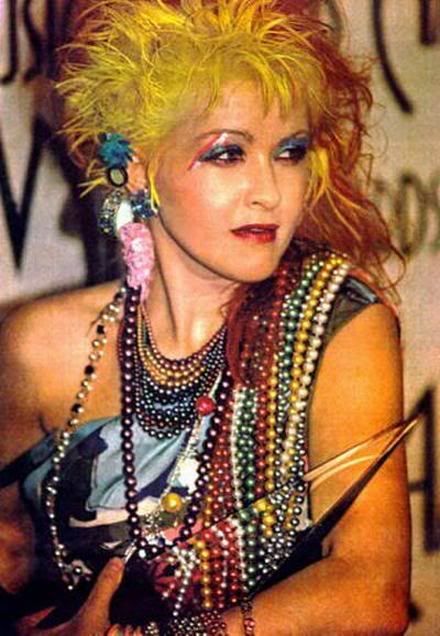
The lolita girl likes loud, busy fashion and being ‘wacky’ and eye catching, basically.
Chic:
小さいころから飼っているヨボヨボの犬がいる。
She has a wrinkled dog that she’s had since she was littleLolita:
アンチックのぬいぐるみを買ってベッド・ル ームに置いている。
She bought an antique stuffed animal and keeps it in her bedroom.
This is an odd one, but I think the gist is that the Chic girl has a worn plush dog or an elderly real dog that is dear to her and she cherishes it. While the lolita girl bought an antique stuffed animal because it’s trendy and it’s not… velveteen rabbit real.
Chic:
誰にも会わず独りきりで週末をすごせる。
She can spend the whole weekend alone without seeing anyoneLolita:
2時間以上独りでいるとたまらず、友達に電 話をして2時間以上長話ししてしまう。
If she goes more than 2 hours by herself, she has to call her friend and talk on the phone for over 2 hours.
In short, the chic girl is comfortable with her self and her thoughts, but the Lolita girl has to constantly be engaged with her friends, she can’t entertain herself alone, she can’t spend time alone, she’s probably chitchatting about meaningless things. It’s kind of like a commentary on her self sufficiency and her inability to entertain herself, I think.
Chic:
愛しているから、愛している。
I love you because I love youLolita:
愛されているから、愛している。
I love you because you love me
This one is subtle and really needs a real translator I think. My best guess is that it’s getting at the idea of loving people for who they are (or people loving the Chic girl for who she is) versus loving people who love you (or the lolita girl only being liked by the people she shows affection for because she’s showing them affection). If it’s either of those, then it’s going back to the idea that the lolita girl is less likeable, she’s vain, she cares about what other people think about her and likes being liked, while the Chic girl is more secure and likeable.
Part two of the article is a photo spread.
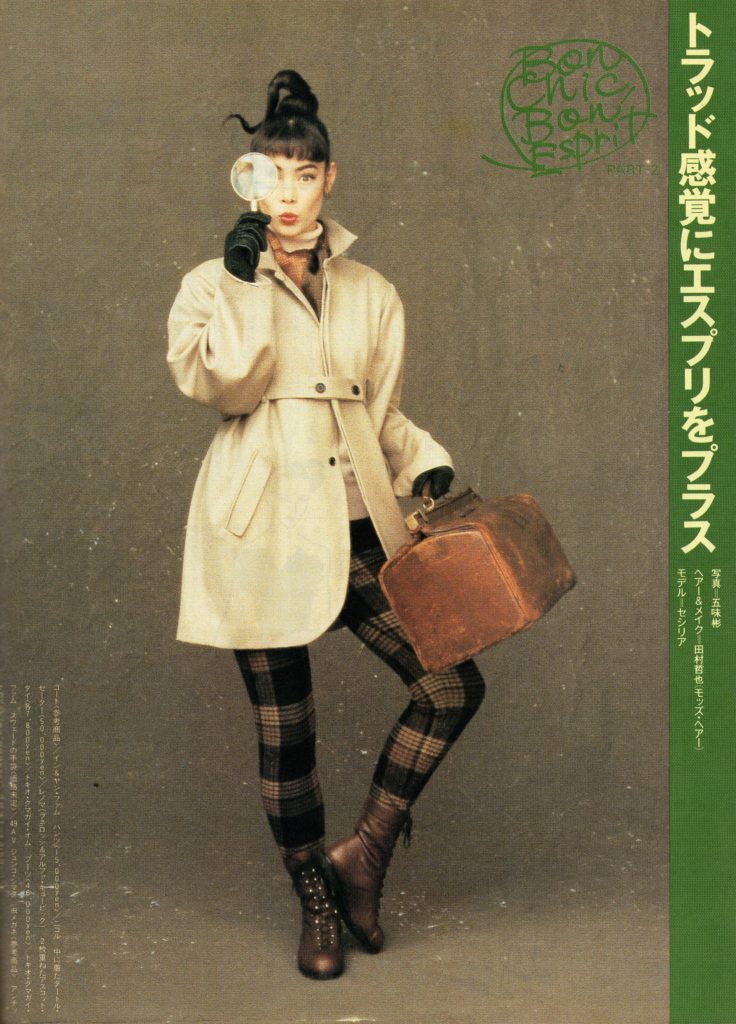
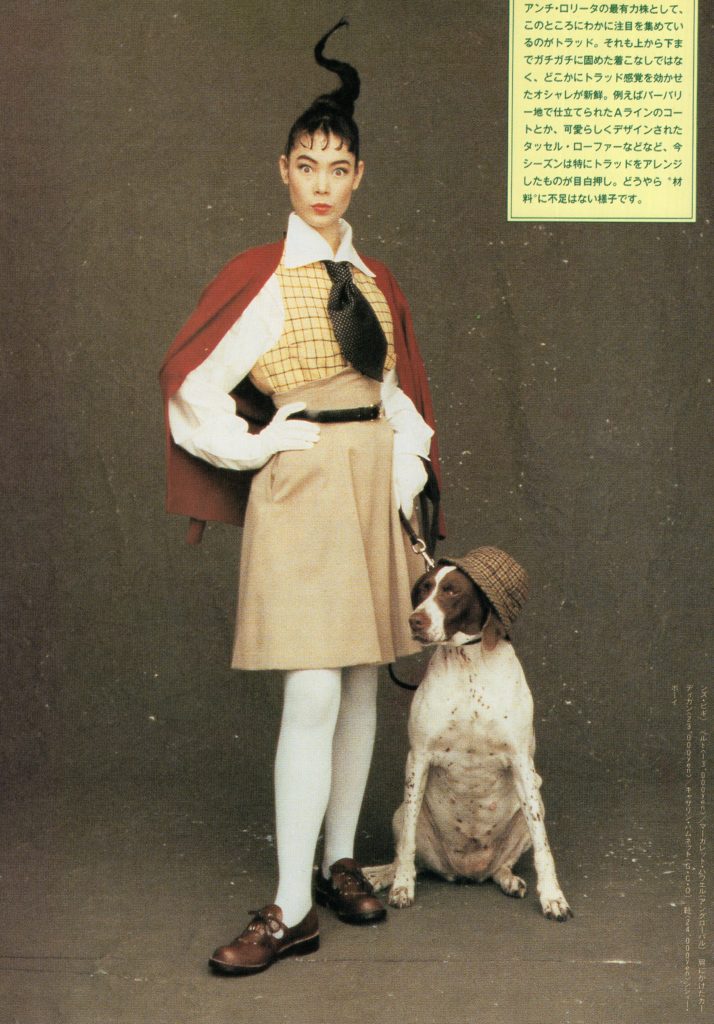
It starts off with a set of photos with a caption that roughly says something to the effect of “Adding espirit to classic fashion sense”
The caption on the opposite page goes on to say….
アンチ・ロリータの最有力株として、このところにわかに注目を集めてい るのがトラッド。 それも上から下ま でガチガチに固めた着こなしではな く、どこかにトラッド感覚を効かせ たオシャレが新鮮。 例えばバーバリ一地で仕立てられたAラインのコー トとか、可愛らしくデザインされた タッセル・ローファーなどなど、今 シーズンは特にトラッドをアレンジ したものが目白押し。 どうやら“材 料に不足はない様子です。
Lately the Trad style is attracting attention as the most influential anti-lolita look. From the top to the bottom, it doesn’t have a stiff look, but it has a fresh sense of style. For example, this season is full of things from traditional fashion style like A-line coats made by Burberry, their cutely designed tassel loafers, and other things like that. Apparently, “there is no shortage of materials”.
I’m not going to lie, they spent all this time in part one suggesting the lolita girl was inferior for her wacky attention getting hair styles, and then they throw this very Cindy Lou Who editorial hair style at us along with the wacky over-sized tie. Which, I have to say, is not really selling their whole timeless elegance message to me very well. Though the look on the left is arguably well put together.
Trad / Traditional is related to the Ivy look, by the way and was trendy in the early 80s in Japan. Here is an article about that style from Olive volume 16 in 1993. I’m not going to pull out the text, because that’s not what we are looking at today, but some images just for context.
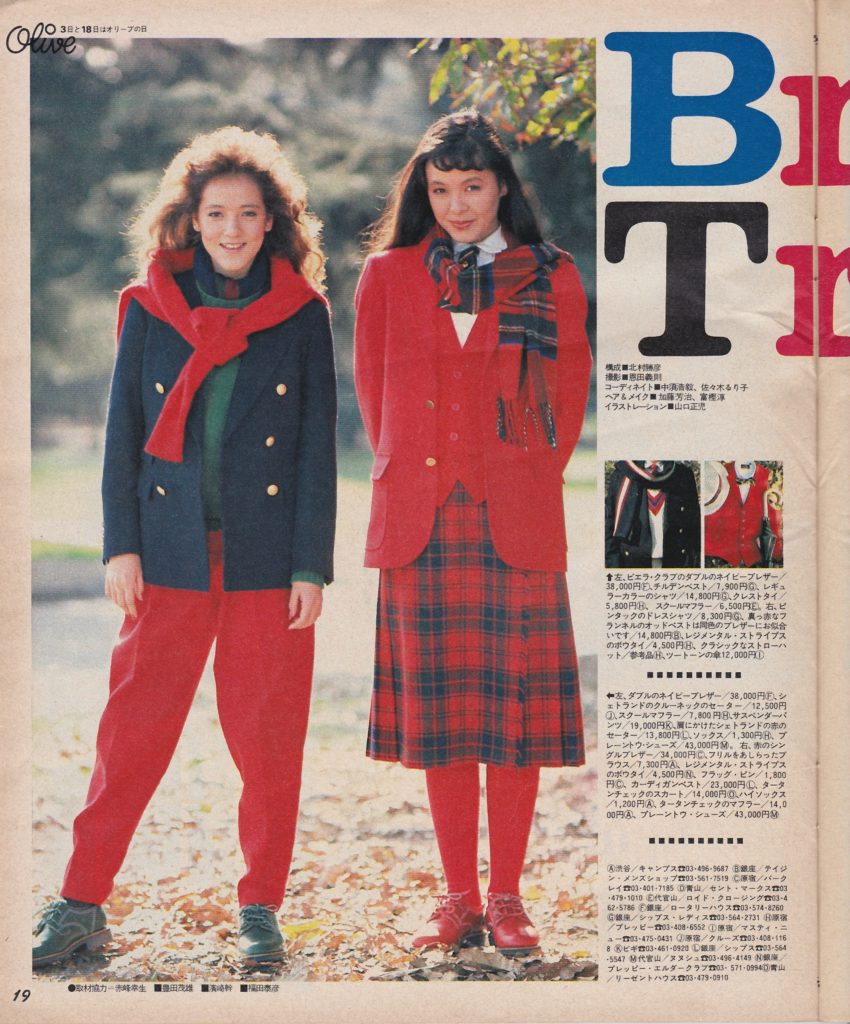
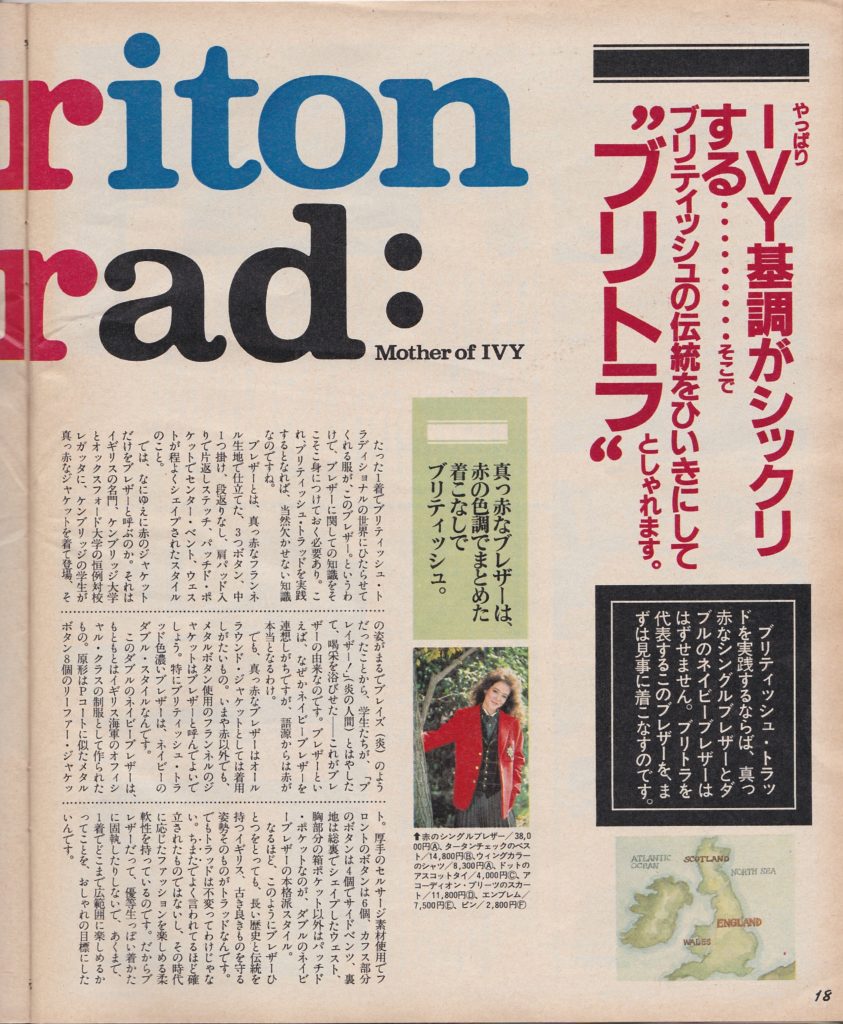
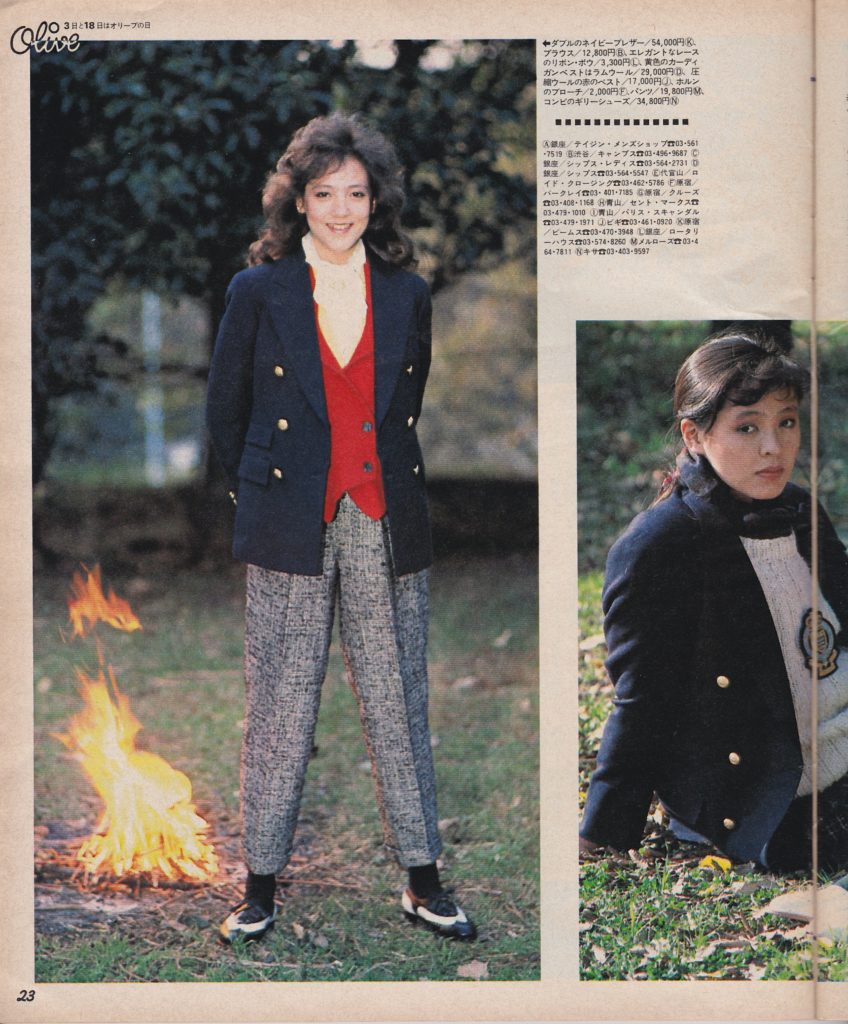
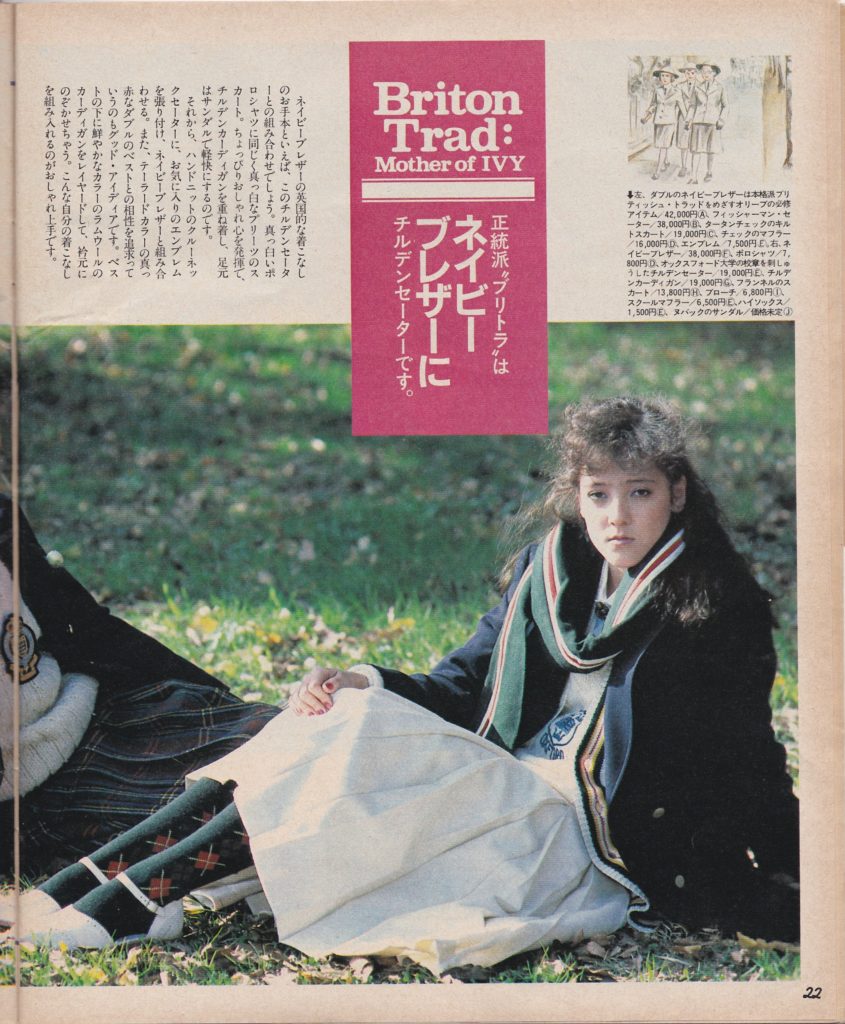
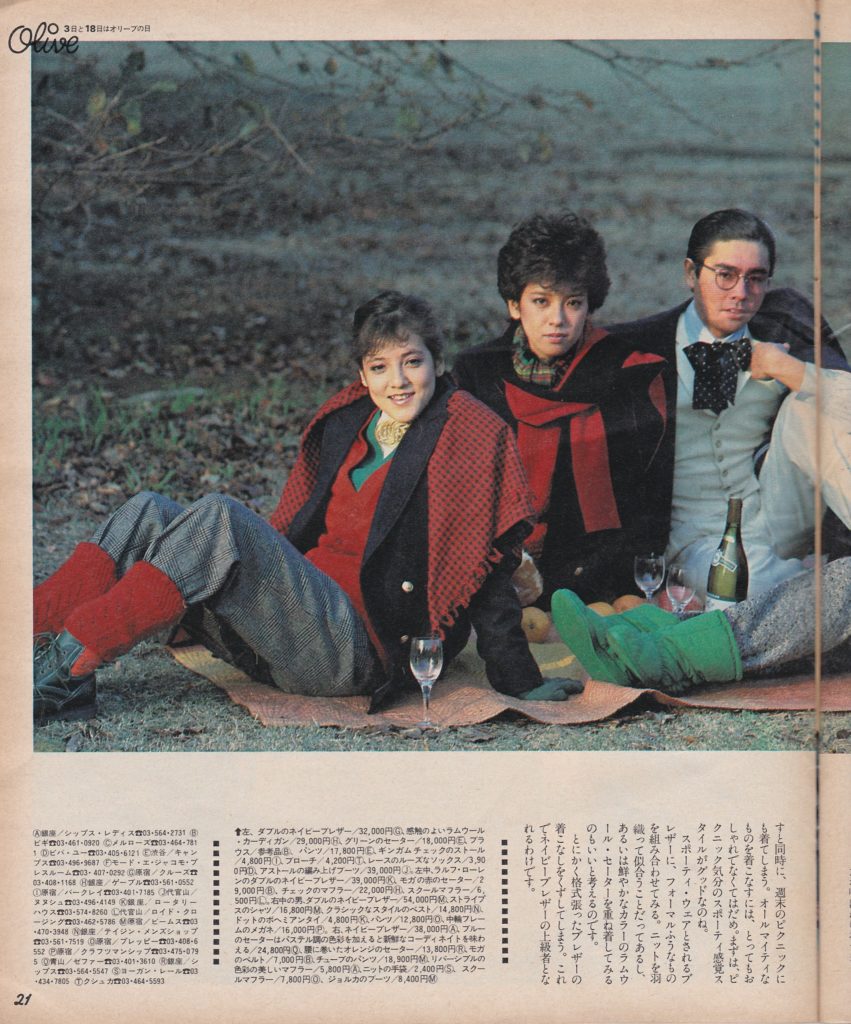
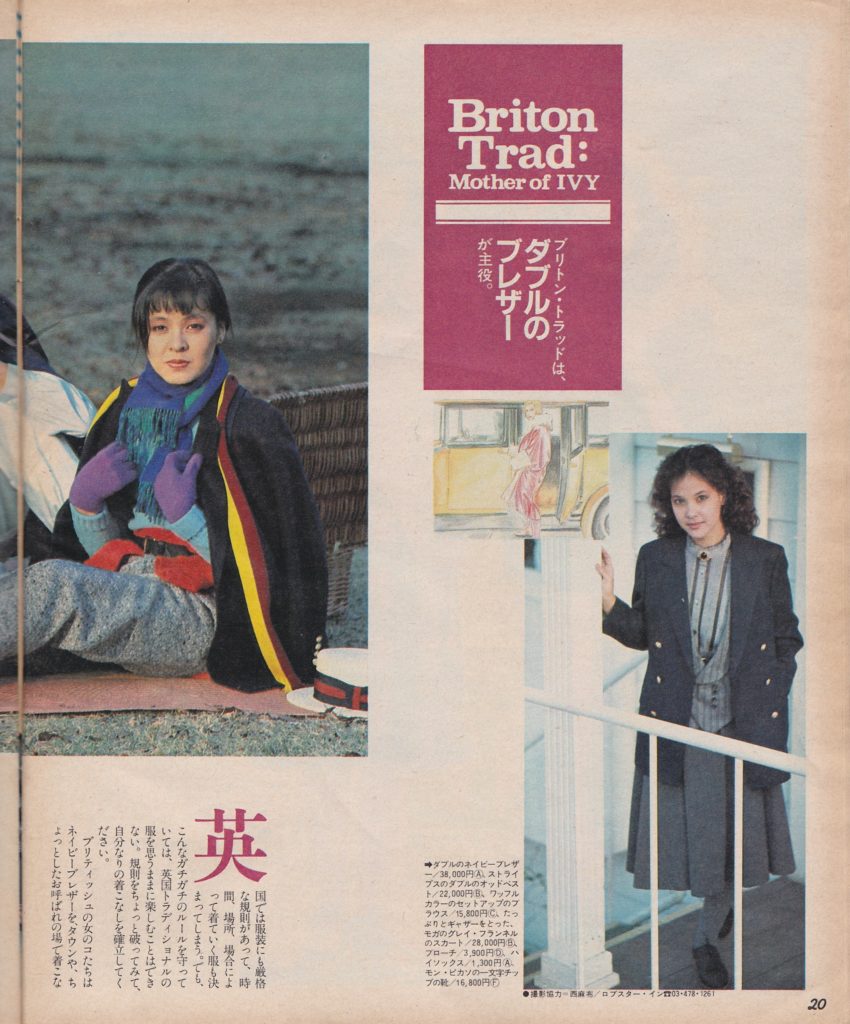
This is really interesting to me because Olive was selling a sort of student in paris dream life that very much was in line with the ‘chic’ girl at this time, but at the same time, readers of Olive would become the Olive girls who would become lolita in time.
Anyways, moving on…
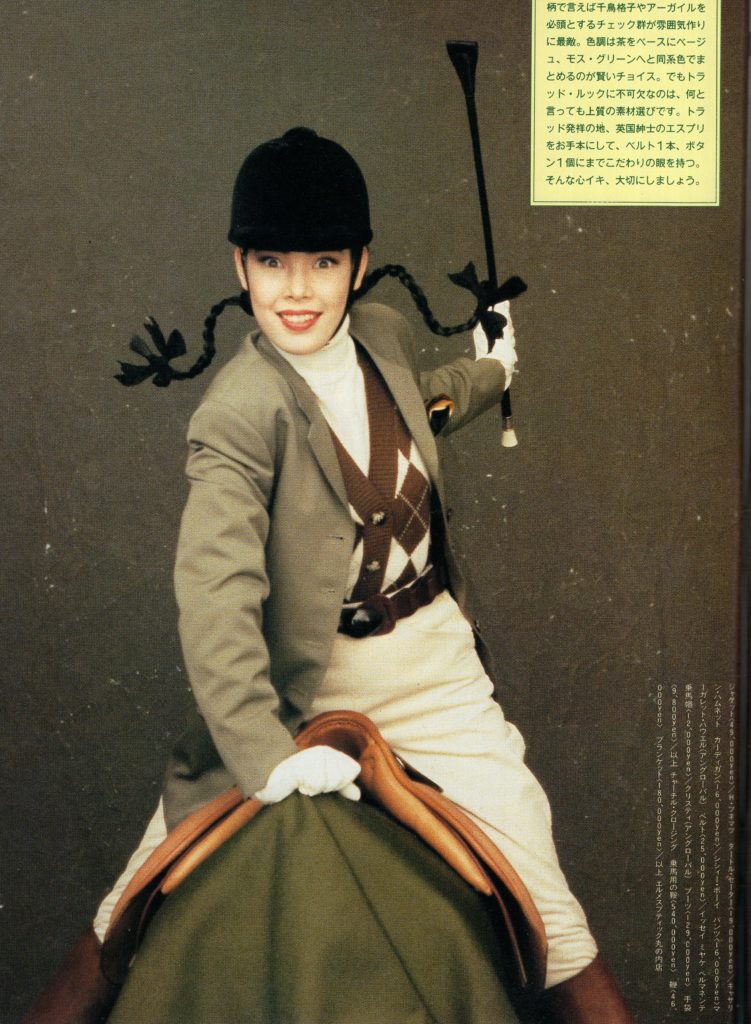
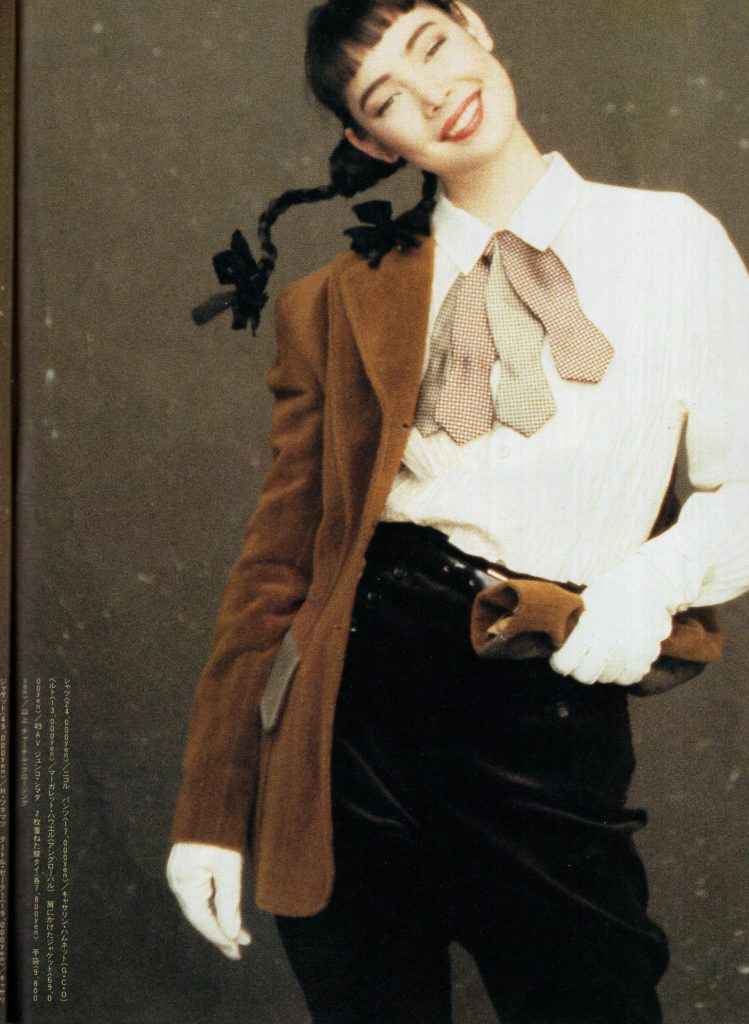
Again, very editorial hair. I get that they want it to show movement and that it’s a fashion advertisement, but these wired braided pigtails are not really what they seemed to be suggesting fit.
柄で言えば千鳥格子やアーガイルを 必頭とするチェック群が雰囲気作りに最敵。 色調は茶をベースにベージュ、モスグリーンへと同系色でまとめるのが賢いチョイス。 でもトラッド・ルックに不可欠なのは、何と言っても上質の素材選びです。 トラッド発祥の地、 英国紳士のエスプリをお手本にして、ベルト1本、 ボタン1個にまでこだわりの眼を持つ。 そんな心イキ、大切にしましょう
In terms of patterns, houndstooth and argyle checks are the best for creating a good aesthetic. A wise choice is to use similar colors such as beige and moss green based on brown. But what is essential for a traditional look is the selection of high-quality materials. It’s modeled after the esprit of the British gentleman, which is the birthplace of traditional fashion, and such a gentleman has an eye for making sure every single belt and button is perfect. Let’s cherish such a lively heart
I mean, yeah. If you are selling the Ivy look, beige, brown, mossy brown green. Houndstooth and argyle. A deliberateness to the embellishments. It all checks out.
The brown jacket is quite nice. The 4 weird shaped ties though? Those are awfully editorial, I don’t think our chic girl would be into that…
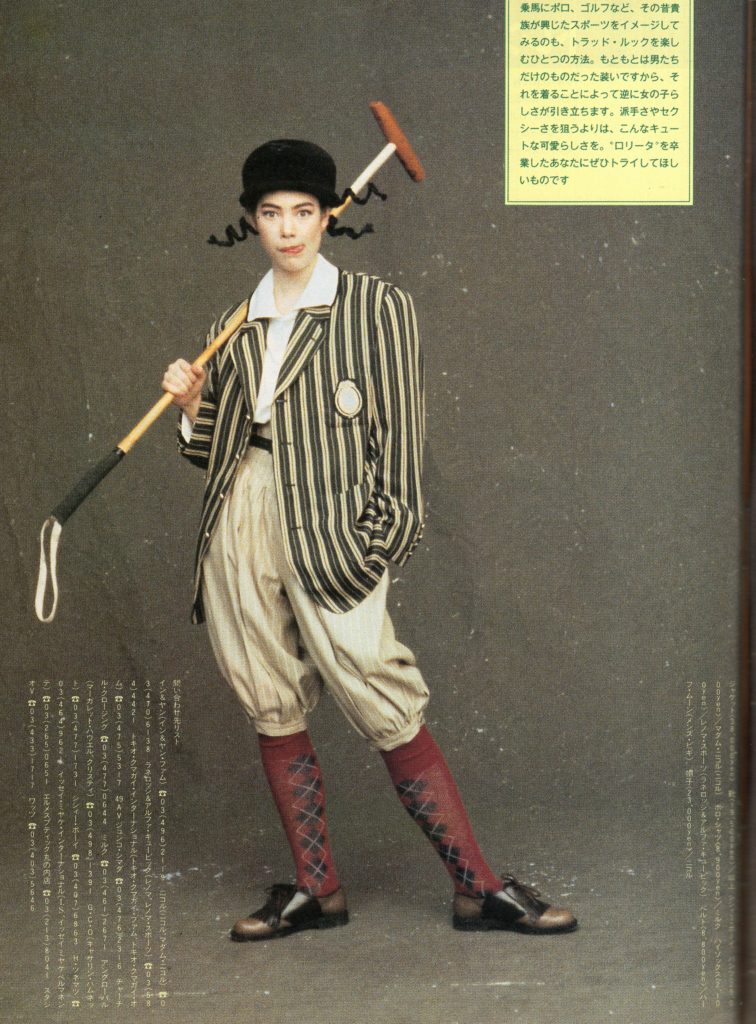
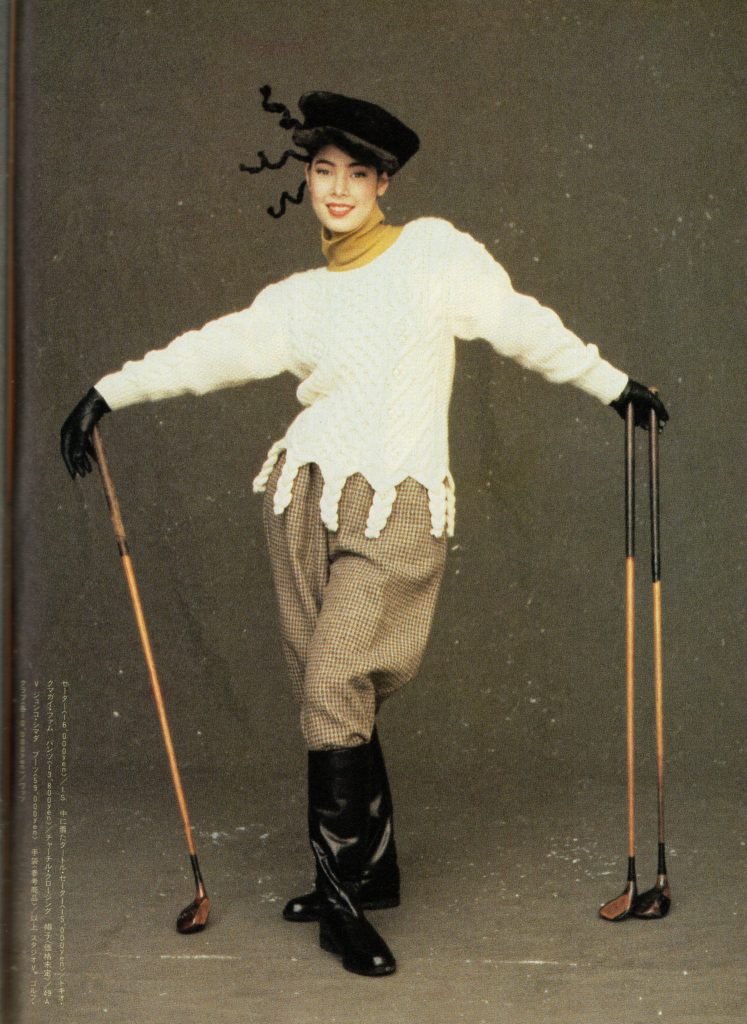
Very editorial hair again, but, I guess it’s ok because it’s a fashion advertisement. Though, I think we already established that our chic girl is bored of designer names and trends, so she probably would never had even read this…
乗馬にポロ、ゴルフなど、 その昔貴族が興じたスポーツをイメージしてみるのも、 トラッド・ルックを楽しむひとつの方法。 もともとは男たちだけのものだった装いですから、それを着ることによって逆に女の子らしさが引き立ちます。 派手さやセクシーさを狙うよりは、こんなキュートな可愛らしさを。 “ロリータ”を卒業したあなたにぜひトライしてほしいものです
One way to enjoy the traditional look is to imagine the sports that were enjoyed by the nobility in the past, such as horseback riding, polo, and golf. Originally, it was only worn by men, so wearing it brings out your femininity. Rather than aiming for gaudiness and sexiness, this has a kind of cuteness. If you are ready to give up “Lolita”, you should try it.
Wow. Thanks. I hate it. Like. Do I have to elaborate? Because like, yes, as a woman who finds other women attractive, there is a part of me that, sure, absolutely I would find a woman expertly dressed in a tailored men’s suit jacket of this era to be attractive even if it’s not my style, yes. But they way they put this and the complete lack of tailoring here is just, frumpy. It’s not classy, it’s not cute, and it’s not sexy (and to be fair, they did say it’s not supposed to be sexy) but looking at this just from a female fashion perspective, it’s really not selling it to me. What is going on with these tweed pants and the galoshes? They just… they aren’t good. This is not good. Sorry, I apparently have feelings about this. I think partly because I have seen so many spreads in like Olive from the 1980s that are significantly more sophisticated and cute.
Lastly, there is another section that often gets attention from the same magazine, and that’s the evening wear portion.
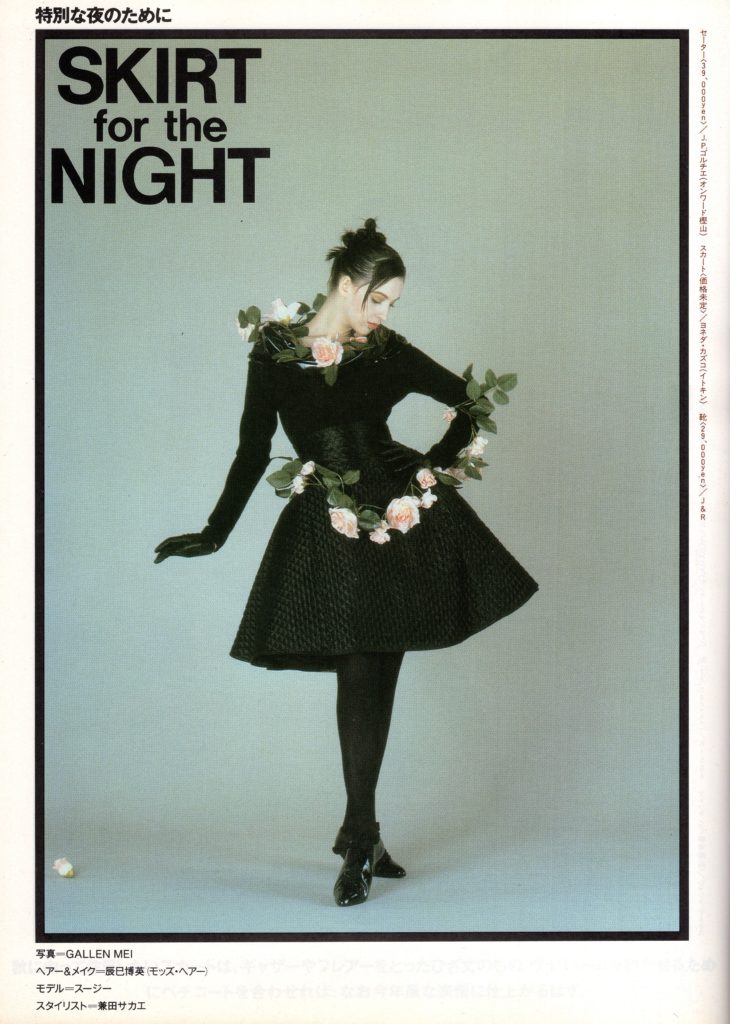
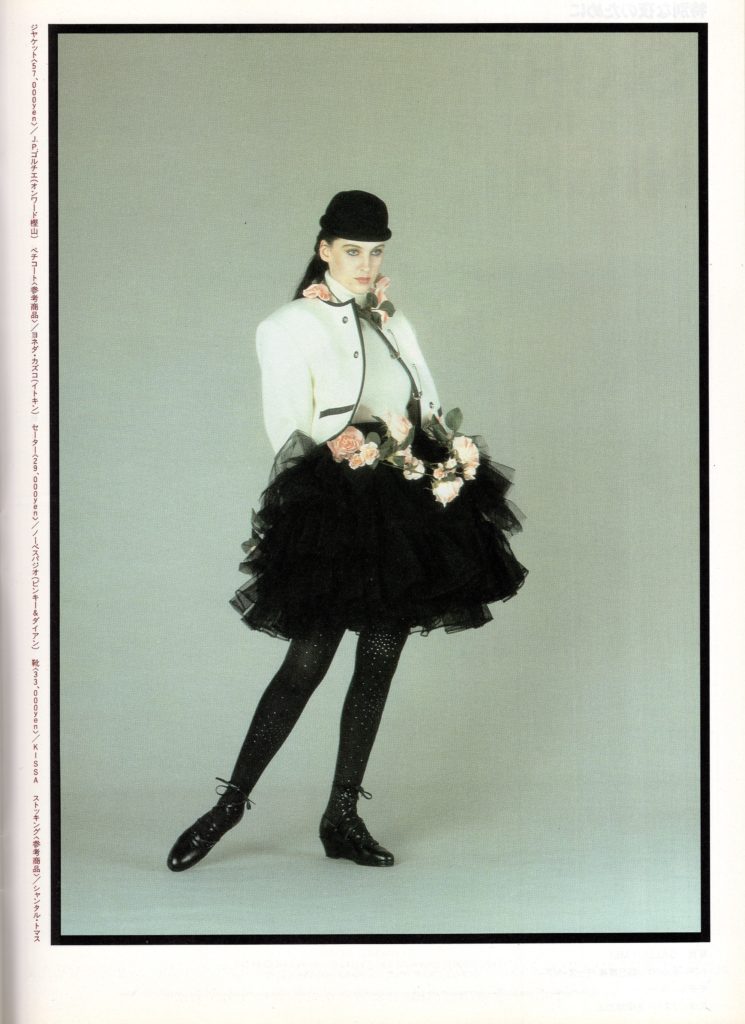
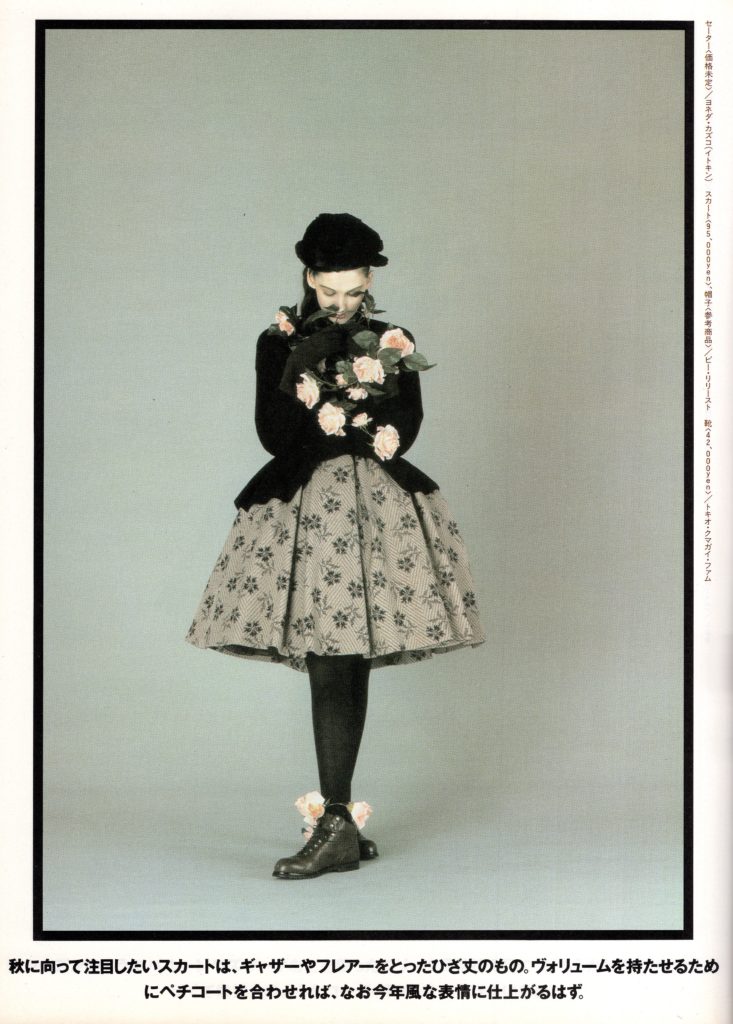
Most of the images in this section don’t have a caption other than the breakdown of where the items are from, but a few have captions under them. The first of them is this one on the right.
秋に向って注目したいスカートは、ギャザーやフレアーをとったひざ丈のもの。 ヴォリュームを持たせるため にペチコートを合わせれば、なお今年風な表情に仕上がるはず。
The skirts you should pay attention to in autumn are knee-length skirts with gathers and flares. If you match it with his petticoat to give it some volume, it will still look like this year’s
This is very, very interesting. Because this is a fashion magazine telling us the look for the season is, well, knee length skirts with petticoats.
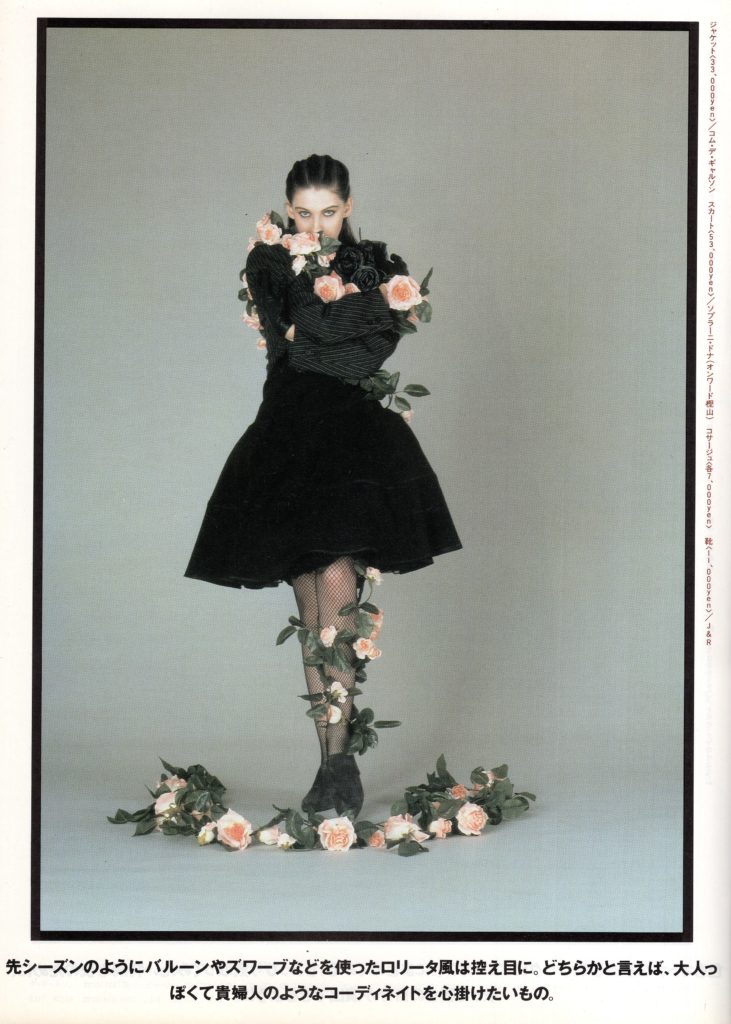
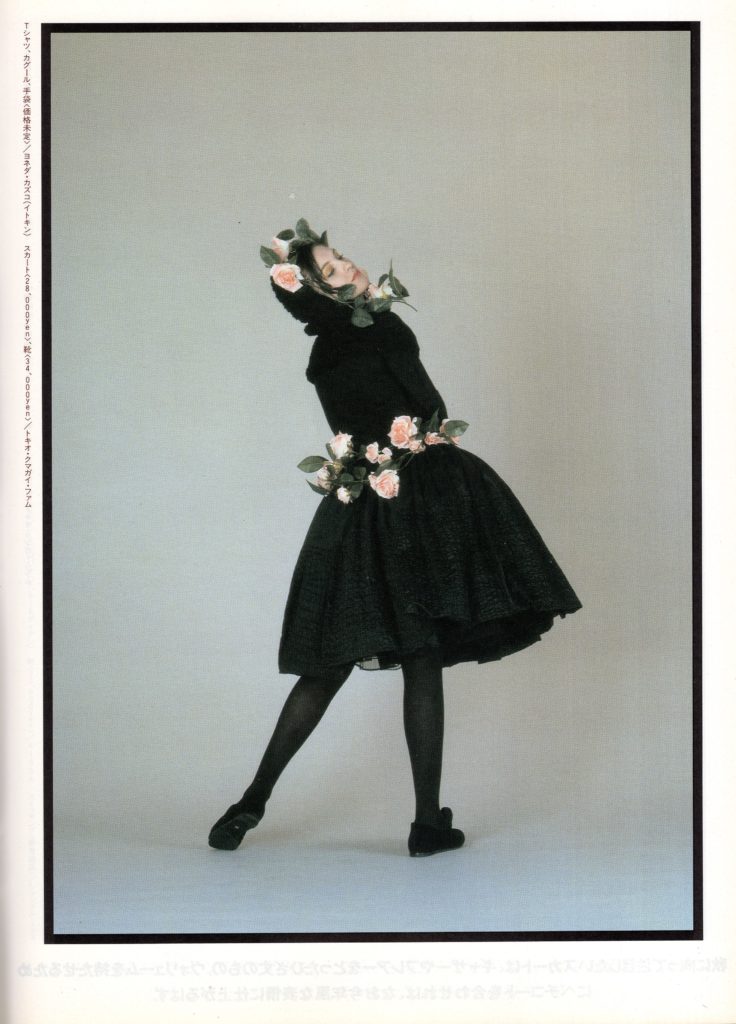
Then we have this set of black skirts. The jacket on the left is Comme des Garcons, most things here aren’t alt Jfashion brands that are well known, they are just… evening wear. That high waist skirt on the left though wouldn’t look out of place in a lolita coord.
先シーズンのようにバルーンやズワーブなどを使ったロリータ風は控え目に。 どちらかと言えば、大人っ ぼくて貴婦人のようなコーディネイトを心掛けたいもの。
The Lolita style with balloons and zouaves like last season should be kept to a minimum. If anything, as an adult, you should want to coordinate like a lady.
So this is the first point in all of this where they have given us something very concrete to define lolita fashion and a time frame. It’s saying Lolita fashion in 1986 (or maybe even the spring of 1987) was balloon skirts, which we mentioned before, and zouaves, which are pants that end right under the knee and are baggy. Like bloomers, or victorian boy’s pants.
So, lolita fashion was balloon skirts and probably bloomers or bloomer-like pants. And those things are out, and in their place it’s knee length skirts that aren’t balloon skirts, with petticoats under them. And this new thing, to them, in fall of 1987, this new thing is not lolita. (who wants to tell them?)
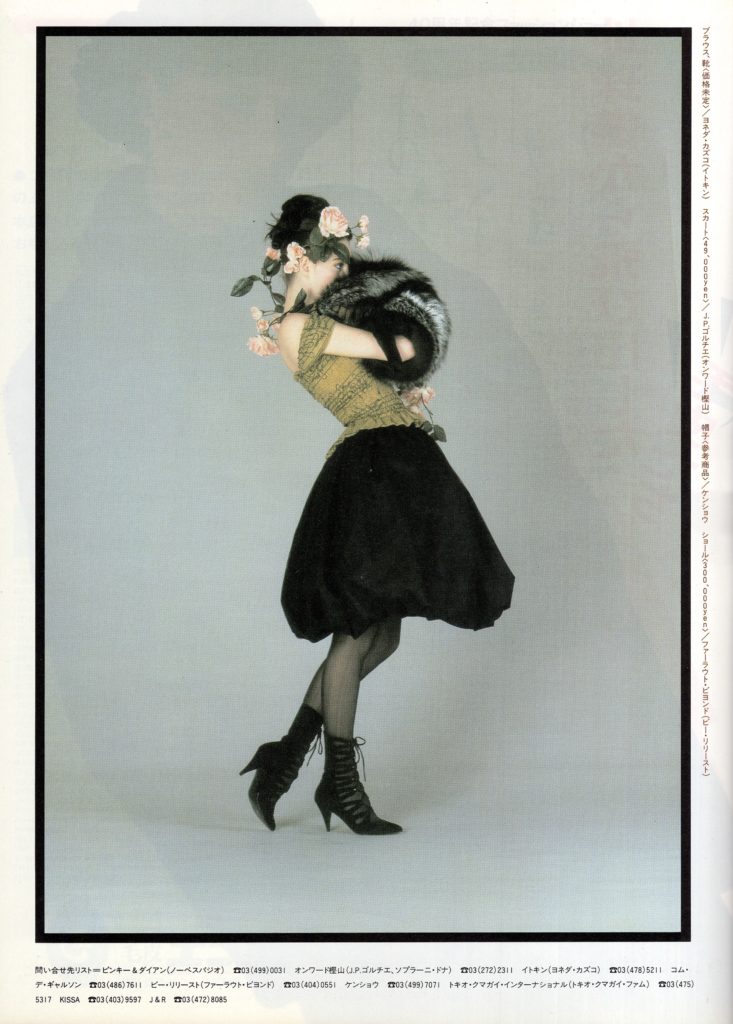
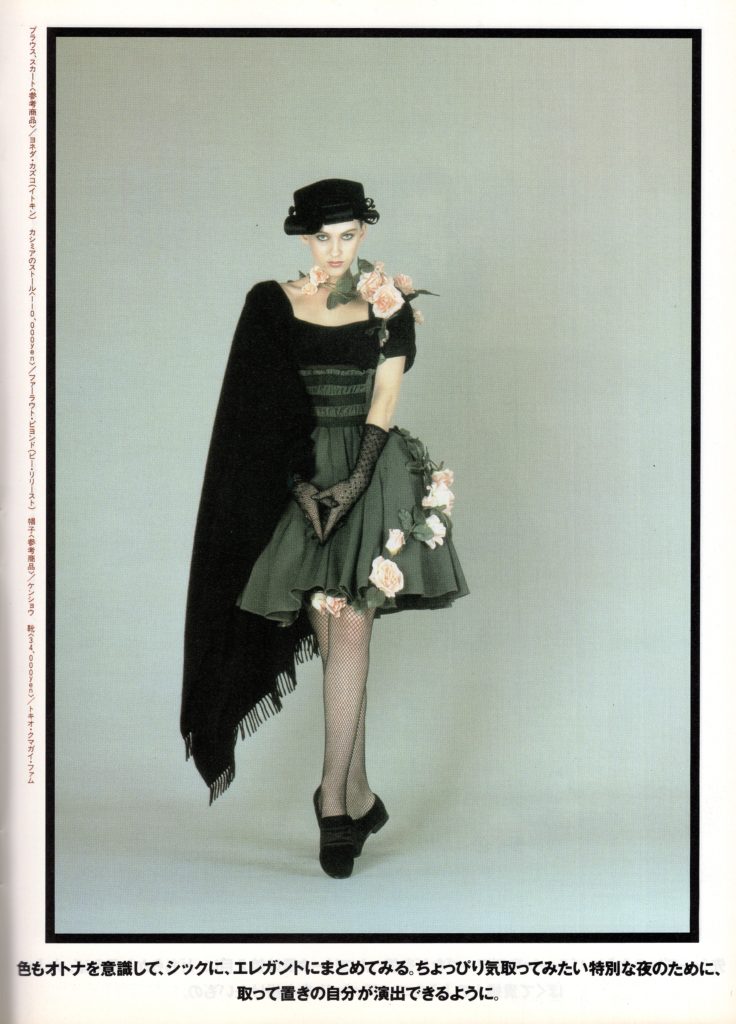
And then lastly, we have another caption and the shop list. Kenzo is listed, Jean Paul Gaultier… like, it’s evening wear. It’s just general evening wear. But man does that green skirt have a lot of elements that would not be out of place in lolita! The designer for that is Yoneda Kazuko (ヨネダ・カズコ) and their work was sold at a department store similar to Nordstrom. I found a video of their work, and it’s just… it’s just 1980s women’s fashion.
色もオトナを意識して、シックに、エレガントにまとめてみる。 ちょっぴり気取ってみたい特別な夜のために、 取って置きの自分が演出できるように。
The colors are also grown up, chic and elegant together. For those special nights when you want to flirt a little, so that you can make yourself feel special.
It’s also interesting they just told us not to wear balloon skirts and then right on the left there is a balloon skirt.
So, now that we have gone through all of the comparisons… let’s talk about what they are talking about… at least as far as I can figure it out.
Their Lolita Girl wears bubble skirts with Micky Mouse shoes, has thick eyebrows and transparent glasses. She likes Adidas, hides her figure with her clothes, wants to be seen as cute and doesn’t look her age. She wears flashy clothes like Cyndi Lauper, childish clothes like a specific Jpop star, and wishes to be essentially what we could call an idol today. She arguably has poor, or at least not timeless, taste and is caught up in being on trend all the time to the point where she maybe misses out on the ‘important’ things in life. She’s childish, insecure, materialistic and focused on external validation.
She’s being compared to a timeless, classy, sophisticated woman who doesn’t put a ton of stock into what other people think, and is secure and comfortable in her own skin.
I don’t think this necessarily really is describing a very specific fashion style. It’s describing someone who wears alt fashion / follows trends, probably, yes, but it’s not quite a set, single fashion style. The balloon skirts, the zouaves? yeah, those could be predecessors to our lolita. But the Adidas? There are some other posts I’m in the middle of working on still which look at some sources from the early1990s and one thing that stands out to me from one of them is the idea that the style they were calling lolita fashion around 1993 was something that had been around, but hadn’t had a name and had been something worn by fashion students and such, not something mainstream. In that sense, I think this is maybe a single piece of a larger puzzle. I don’t think this lolita girl was wearing the same things that a lolita in 2002 would have worn, but I do think the lolita girl in 2002 likely was called a lolita because of the lolita girl of 1987. In other words, my thought is that maybe this name existed for a trope of a type of a young person in 1987, and perhaps slightly before, and maybe the young people associated with that trope, over the next ~5 years, found there way over to the style that would eventually become old school lolita fashion. The fact that the lolita girl is said to be following trends, and that they are introducing a trend of knee length skirts with petticoats as evening / party dresses… the way that it’s explained that they were wearing something specific last season… I could see it evolving over time.
Or maybe these things aren’t related at all. Maybe there is another catalyst all together. Maybe there is something hidden in the text between the lines here that we don’t see as modern outsiders that the readers of this magazine would have just known. It’s hard to say.
One thing that does seem to be odd to me as a reader though, is the idea that this could be the first mention of the lolita girl concept in print. It may be the first time the words lolita and fashion are smashed together, but I would be surprised if there weren’t older instances of lolita being used to describe this trope of a young woman. It seems strange to have this criticism that suggests that the writer is tired of these lolita girls, if these lolita girls hadn’t already existed for some time. It also is weird for them to talk about what the lolita girls wore last season if they weren’t lolita girls 6 months, or a year ago.
I think the article also suffers from being too close to the start of the name being used. Lolita girl’s fashion doesn’t look like lolita fashion completely yet, but that may be because what we really, truly consider lolita fashion today, hadn’t been introduced to the lolita girls of 1987 yet.
In the end, this article has given me a lot to think about, and I think it’s a really interesting. I hope you enjoyed coming on this weird meandering path with me, and again, if you want to use this article academically, please do work from the original text, or contact a competent professional translator. I’m certain I’ve made mistakes. And as always, I welcome your thoughts on the subject in the comments below.
I’m so glad that the Research Facebook group was created by the way! It’s been full of very interesting finds. Thank you for making it and for posting this article which is about the Eternal Question™ of how we got this name.
This article is very interesting in that it kind of reads very critical of Japanese society? The author describes Lolita sensibilities as popular because it’s in line with Japanese social/mental state and proceeds to eviscerate the Lolita girl. I’m all for self critique of one’s own society, but this seems like a lot of projection and straw manning. I thought chic women weren’t supposed to care about what others are doing? 🤣
The author gives the impression of those stories of Japanese people who idolize France/Paris and then go into shock that it’s not a tasteful paradise straight outta Rose of Versailles. Lol
This is pretty interesting ngl. Thanks for sharing!
This was very cool! And the idea that they’re going on about these lolita girls just following trends when the writers are also pushing these trends to them, means that lolitas- not just in the historical sense, but as they themselves described these girls- were created by them! Like, not even the Olive magazine as a whole, but THESE writers! They hated (or at least complained about) their own creation! That’s hilarious!
I would love to know what readers were thinking at the time when they read this article, considering the tone and the hypocrisy in their photos.
This is such an interesting post!
Maybe the “Lolita” girl at the time was more a designation of a loud teenager who were some mismatched burando? I really can’t match a BTSSB or AP lover with the “wears Adidas” thing, hahaha.
In the end, it looks like the tips and styling that Olive magazine made pointed those proto-lolitas into the direction we know Lolita Fashion had in the 90s. The dark look with poofy skirt and roses are truly an inspiration <3
This was so interesting!! I strangely do somewhat relate to/understand some of the author’s criticisms- The “lolita girl” character traits can definitely describe some people today (or more accurately, describe how they are seen by other people) and it’s kind of an archetype that I’m afraid of falling into, as someone who cares a *lot* about fashion. It’s just not something I ever could describe before. I love your response to it, too- It makes me feel better about not always being the “chic girl”, because, the “chic girl” fashions were pretty terrible, haha. And maybe that’s true today too! Thanks so much for the translation of this and your thoughtful response/analysis of it.